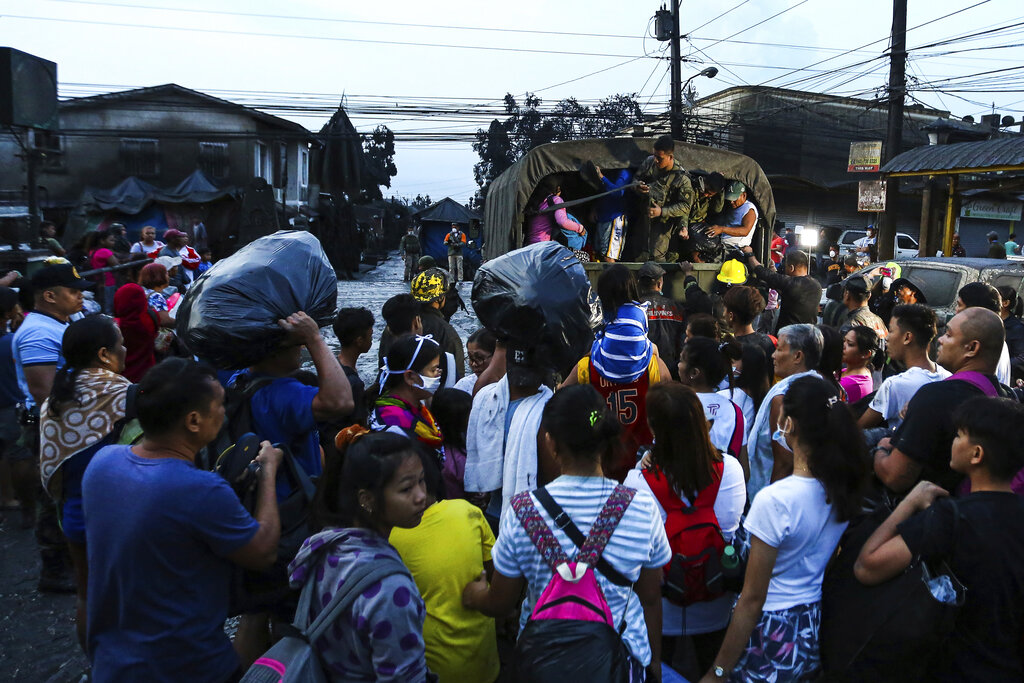Batangas folk appeal for water, relief

Residents wait to be evacuated as heavy ash and debris from the Taal volcano eruption continues to cover their town in Talisay, Batangas, southern Philippines on Monday, Jan. 13, 2020. Red-hot lava gushed out of a volcano near the Philippine capital on Monday, as thousands of people fled the area through heavy ash. Experts warned that the eruption could get worse and plans were being made to evacuate hundreds of thousands. (AP Photo/Gerrard Carreon)
TALISAY, Batangas, Philippines — In all of his 87 years living on the shores of Taal Lake, boat operator Bernabe Manalo thought he had seen the worst when the volcano last erupted in 1977.On Monday, he was proven wrong.
Manalo was among the lakeshore residents of Talisay, Laurel, Lemery and Agoncillo towns who were being evacuated to escape the erupting Taal Volcano on Monday morning.
“The quakes were really strong this time,” Manalo said. “It was endless and felt like it was trying to pry out the house.’’
He and his family of six fled to a relative’s house in nearby Santo Tomas town, but returned to his house in Laurel to gather all his family’s valuables.
Nothing to buy
“We better leave now. I’m afraid this time she means business,” Manalo said, pointing to the volcano as it formed a new smoke column.
Article continues after this advertisementOthers who opted to stay behind, like 44-year-old fisherman Cesar Dalisay of Barangay Zone 4 in Talisay, are clamoring for basic needs like water and relief goods.
Article continues after this advertisement“We may have the money but there [were no stores open]. We are wondering where the relief goods are at this time of disaster,” he said.
For Dalisay, it was the first time the area experienced such a disaster, noting that the 1977 eruption did not trigger suffocating ashfall.
“See that old tree there? That survived all disasters, except this one,” he said, pointing to an acacia tree that was felled by the sheer weight of ash on its foliage.
Downed trees, power lines
The town was without power as the ashfall downed trees that fell on power lines. The water supply from the local distributor was also cut, after the quakes formed cracks on the ground.
Talisay turned into a virtual ghost town after its residents abandoned their homes and evacuated to centers and to relatives’ houses in neighboring towns beyond the 10-kilometer danger zone.
Traffic jams
The evacuation was made more difficult by thick mud on the roads and sidewalks, with rescue trucks as well as private vehicles sliding on the road, causing traffic jams that stretched for about 2 km.
But the volcano’s rumbling provided the greatest fear for Rex Opeña and his family, who sought refuge at a friend’s house in upland Barangay Miranda, fearing the quakes would trigger a tsunami and gobble up the residential and commercial areas of Barangay Zone 3.
“What was really painful for me was the endless cries of my children whenever the ground shook; we felt so helpless,” he said, as he, his brother and their families, waited for rescue vehicles to bring them to Tanauan City.
Residents said they began scampering to safer ground on Sunday afternoon after Taal Volcano started to trigger quakes, spew thick smoke, and rain volcanic pebbles and thick ash on communities on Taal Lake’s northeastern side.
Neighboring Tanauan City was covered with almost 5 centimeters of volcanic ash, which turned into mud following an evening downpour, forcing vehicles to skid on Talisay-Tanauan road by morning.
The volcano began to show some significant activity around 11:30 a.m. on Sunday, with a strong quake, followed by the billowing of a thick smoke column from its largest crater, according to Tanauan resident Bernard Valenzuela, 47.
‘Apocalypse’ landscape
“What scared us more were the kernel-sized volcanic pebbles raining down on our roofs. It eventually stopped, but we knew it was just the beginning,” he said.
The ashfall turned the surrounding communities around Taal Lake into a landscape resembling an apocalypse, with trees, buildings and rooftops covered by thick, gray dust and mud.
Disaster operations personnel from neighboring areas of Batangas, who rushed to Talisay to augment relief activities, lamented the lack of “rescue assets” to reach certain areas and extricate residents.
Lack of preparedness
“It would seem that DRRM (disaster risk reduction and management) personnel are relegated to just clerical work, recording meaningless figures on paper,” an officer, who asked not to be named, said in dismay.
He noted that rescue operations were made slower by poor traffic management, with stalled vehicles as well as rescue equipment that were on standby blocking portions of the highway.
Residents along the lakeside communities whom the Inquirer talked to lamented that this latest eruption showed their lack of preparedness for disasters “despite all the government rhetoric.”
Prima Tambalo, 52, said she was forced to open her store in Barangay Santa Maria in Laurel town over pleas from neighbors, who were left with no food.
“We have already evacuated as of [Sunday] to Batangas City, but I had to come back to open the store because my neighbors kept calling me, begging me to reopen,” she said.
Tambalo said residents there did not know how and where to get relief goods.
Village council member Dhanrey Villarmia, 21, who supervised the evacuation of residents from the Taal Lake Central Fish Port in Leviste village, admitted that rescue operations were made difficult by many locals refusing to leave.